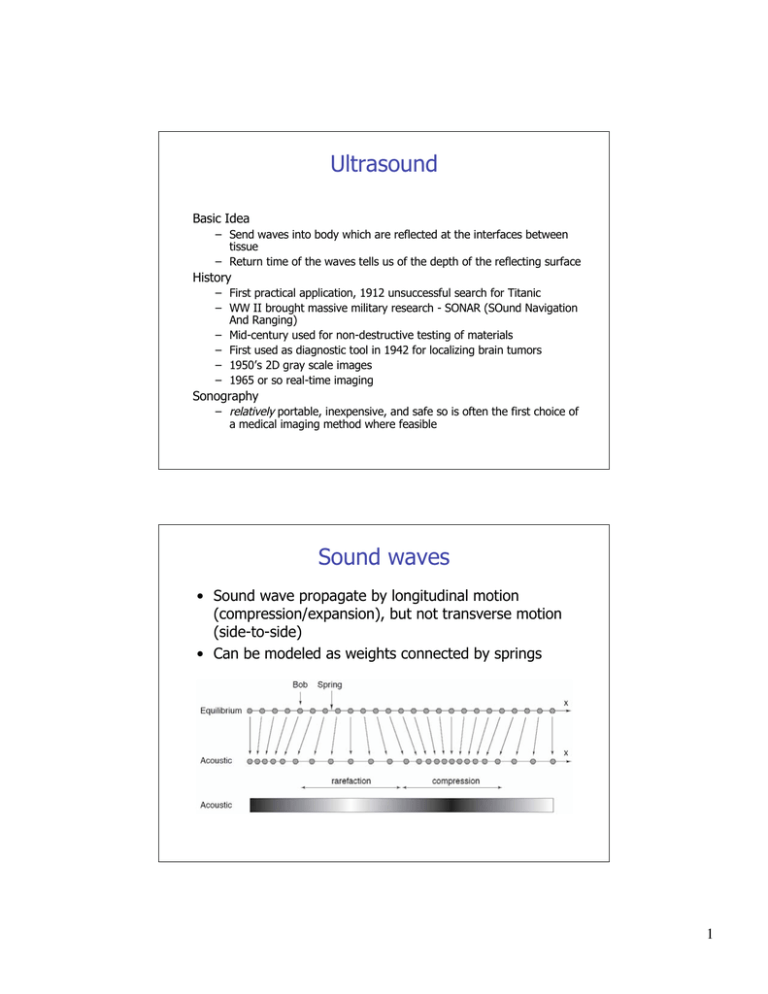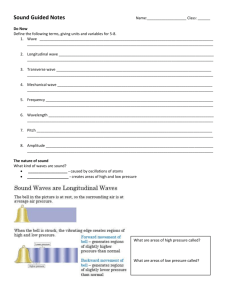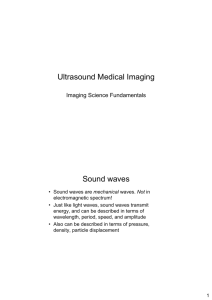Ultrasound Basic Idea
advertisement

Ultrasound Basic Idea – Send waves into body which are reflected at the interfaces between tissue – Return time of the waves tells us of the depth of the reflecting surface History – First practical application, 1912 unsuccessful search for Titanic – WW II brought massive military research - SONAR (SOund Navigation And Ranging) – Mid-century used for non-destructive testing of materials – First used as diagnostic tool in 1942 for localizing brain tumors – 1950’s 2D gray scale images – 1965 or so real-time imaging Sonography – relatively portable, inexpensive, and safe so is often the first choice of a medical imaging method where feasible Sound waves • Sound wave propagate by longitudinal motion (compression/expansion), but not transverse motion (side-to-side) • Can be modeled as weights connected by springs 1 Ultrasonic Waves and properties • • • Mechanical waves are longitudinal compression waves “Ultrasound” refers to frequencies greater than 20kHz, the limit of human hearing For Medical imaging typically 100 Times higher frequency than audible by human typically 2 to 20 MHz Transmission and Reflection 2 Propagation of ultrasound waves in tissue Scattering • Specular reflector is a smooth boundary between media (conventional view of reflections • Acoustic scattering arises from objects that are size of wavelength or smaller • Most organs have characteristic structure that gives rise to defined scatter “signature” Specular - echoes originating from relatively large, regularly shaped objects with smooth surfaces. These echoes are relatively intense and angle dependent. (i.e. valves) - Reflection from large surfaces Scattered - echoes originating from relatively small, weakly reflective, irregularly shaped objects are less angle dependant and less intense. (i.e.. blood cells) Reflection from small surfaces Basic Idea • Along each line we transmit a pulse and plot the reflections that come back vs time 3 The Speed of Sound • The compressibility κ and density ρ of a material, combined with the laws of conservation of mass and momentum, directly imply the existence of acoustic waves • Ultrasound waves travel at a speed of sound c, given by 1 c= !" Variations in Speed • Speed of sound for different materials c= 1 !" 4 Physics of Acoustic Waves • Three dimensional in nature and depend on time • Whatever the physical quantities that are used to describe the sound waves, they must depend upon three spatial variables, x, y, z, and time, t • Particle displacement u(x, y, z, t) associated with the compression and expansion of the acoustic wave • Particle velocity v(x, y, z, t) • Acoustic pressure p(x, y, z, t), which is zero if there is no wave For longitudinal waves, it is straightforward to relate the acoustic pressure to the underlying particle velocity p = vZ where Z = ρc is called the characteristic impedance – This is a like V=IR – Note that v ! c Variations in Speed and Impedance • Speed of sound for different materials c= 1 !" • Impedance relating pressure to particle velocity p = vZ Z = !c = ! " 5 Wave Equation • The acoustic pressure p must satisfy the three-dimensional wave equation " !2 !2 !2 % 1 !2 p(x, y, z,t) $ !x 2 + !y 2 + !z 2 ' p(x, y, z,t) = c 2 !t 2 # & • For a plane wave traveling in the z-direction thus reduces to !2 p(z,t) 1 !2 p(z,t) = 2 !z 2 c !t 2 • An example solution is, p(z,t) = cos k(z ! tc) which has cyclic frequency (in Hertz) of f = kc 2! which also leads to the important relation f = c ! Propagation of ultrasound waves in tissue • Ultrasound imaging systems commonly operate at 3.5 MHz, which corresponds to a wavelength of 0.44 mm when c = 1540 m/s. Refraction • When a wave passes from one medium to another the frequency is constant, and since c changes then so must the wavelength c != f Material 1 Material 2 since λ2 < λ1 we have c2 <c1 6 Propagation of ultrasound waves in tissue • Bending of waves from one medium to another is 'refraction' • Follows Snell’s Law sin !i sin !r sin !t = = c1 c1 c2 incident transmitted reflected since λ2 < λ1 we have c2 <c1 and θ2 < θ1 Total Internal Reflection • Since λ2 > λ1 in this case, we have c2 > c1 and θ2 > θ1 • There can be a 'critical' incident angle θ1 = θC where θ2 = 90 deg, i.e. there is no transmitted wave. In that case there is 'total internal reflection of the wave 7 Attenuation of ultrasound waves in tissue Attenuation is the term used to account for loss of wave amplitude (or ‘‘signal’’) due to all mechanisms, including absorption, scattering, and mode conversion The model of attenuation is phenomenological, meaning it agrees well in practice but is not easily supported by theory We model amplitude decay as A(z) = A0 e! µ A z where µA is called the amplitude attenuation factor and has units cm−1 Since 20 log10 (A(z)/A0) is the amplitude drop in decibels (dB), it is useful to define the attenuation coefficient α as ! = 20 log10 (e) " µ A # 8.7 µ A The absorption coefficient of a material is generally dependent on frequency f, and a good model for this dependency is ! = af b The rough approximation that b = 1 is often used Attenuation of ultrasound waves in tissue Assuming b~1 A(z, f ) = A0 e! afz /8.7 8 Time-Gain Compensation • Depth of signal is related to reflection time, so as time progresses, the signal will be increasingly attenuated Time-dependent attenuation causes severe signal loss if not compensated All systems are equipped with circuitry that performs time-gain compensation (TGC), a time-varying amplification In practice, most systems have additional (frequency dependent) slide potentiometers, which allow the gain to be determined interactively by the operator. This permits the user to manually adapt the system to special circumstances requiring either more or less gain so that subtle features can be seen in the images. • • • Generation of Ultrasound • • • • • A 'transducer' converts energy from one form to another The “Piezoelectric effect” was described 1880 Pierre and Jacques Curie Lead zirconate titanate, or PZT, is the piezoelectric material used in nearly all medical ultrasound transducers It is a ceramic ferroelectric crystal exhibiting a strong piezoelectric effect and can be manufactured in nearly any shape The most common transducer shapes are the circle, for single crystal transducer assemblies, and the rectangle, for multiple transducer assemblies such as those found in linear and phased arrays 9 Beam Pattern Formation • Simple Field Pattern Model Fresnel region Geometric approximation Fraunhofer (or far field) region Approximate field pattern for a focused transducer 10 Collect the Echo Transducers 11 Phased-Array concept for transmission and reception Planar delayed pulses Focused array of piezoelectri c crystals generated wave (transmission) sensitive region (reception) Transducer Arrays 12 Array Transducers • Linear arrays (composed of 256 to 512 discrete transducer elements) (~15 to 20 adjacent elements simultaneously activated sequentially across surface to sweep FOV) • Phased array transducers (composed of 64, 128, or 256 elements) (phase delay varied to sweep across FOV) Side-lobes • Focused arrays typically have larger 'sidelobes' of signal power for transmission and sensitivity for reception 13 (Amplitude) A-Mode • • Along each line we transmit a pulse and plot the reflections that come back vs time Unfortunately, it is very difficult to associate a precise physical meaning with the received signal amplitude vs time Ultrasonic Imaging Modes 14 Ultrasonic Imaging Modes Echo Display Modes: • A-mode (amplitude): display of processed information from the receiver versus time – Speed of sound equates to depth – (only used in ophthalmology applications now) • B-mode (brightness): Conversion of A-mode information into brightness-modulated dots • M-mode (motion): uses B-mode information to display the echoes from a moving organ A-Mode Example Transmission pulse in red, reflected waves in blue 15 Forming an Image • The amplitude values are converted to brightness along a line and displayed on a screen • The line direction is swept across an angular range, either mechanically or electromagnetic beamforming beam sweep Forming Clinical Images Probe locations Two common clinical ultrasound examinations (L) an echocardiogram showing the four chambers of the heart (R) fetal ultrasound, showing a normal fetus at the second trimester of gestation. 16 Complete System Acquisition and Recon Time • For external imaging: each line corresponds to 20 cm. – – – – – Velocity of sound in soft tissue is ~1540 m/s. Travel distance from and to transducer 40 cm Acquisition of line takes 260 µs Typical image has 120 lines for total time of 31 ms. Images reconstructed in real time… So can have temporal resolution of ~30 Hz (30 images a second) • Modern scanners collect multiple scan lines simultaneously usually frame rates of 70-80 Hz 17 Clinical Uses - Cardiac Imaging Right ventricle Left ventricle Right atrium Left atrium • B-mode image of a normal heart Example of M-Mode below 2D B-mode Image 18 Clinical Uses - Neonatal • B-mode image of a fetus. The dark region is the uterus, which is filled with fluid Doppler Imaging 1. Continuous Wave (CW) Doppler: – 2. Pulsed Wave (PW) Doppler: – 3. Continuous sinusoidal wave transmitted with one crystal and reflected wave received with second crystal Pulsed waves transmitted at constant pulse repetition frequency and only one sample as function of time is collected Color Flow (CF) imaging: 19 Doppler Imaging Doppler Imaging Color Flow (CF) imaging: • • • Doppler equivalent of B-mode scan…several pulses instead of one are transmitted/received along each line Calculates phase shift between two subsequent pulses Velocity information in color is superimposed on anatomical gray scale image Red - flow towards transducer Blue - flow away from transducer 20 3D Image Formation Reordering of the known slice locations provides surface-shaded, wire mesh, MIP, or other renditions of the anatomy Comparing 2D to 3D US 21 Dangers of Ultrasound • very minimal in comparison to other methods • development of heat - tissues or water absorb the ultrasound energy which increases their temperature locally formation of bubbles (cavitation) - when dissolved gases come out of solution due to local heat caused by ultrasound high intensity systems actually used for therapy • • Some Ultrasound Uses (short list) • Obstetrics and Gynecology – measuring the size of the fetus to determine the due date –checking the sex of the baby (if the genital area can be clearly seen) – checking the fetus's growth rate by making many measurements over time – detecting ectopic pregnancy, the life-threatening situation in which the baby is implanted in the mother's Fallopian tubes instead of in the uterus – determining whether there is an appropriate amount of amniotic fluid cushioning the baby – monitoring the baby during specialized procedures - ultrasound has been helpful in seeing and avoiding the baby during amniocentesis (sampling of the amniotic fluid with a needle for genetic testing). Years ago, doctors use to perform this procedure blindly; however, with accompanying use of ultrasound, the risks of this procedure have dropped dramatically. – seeing tumors of the ovary and breast • Cardiology –seeing the inside of the heart to identify abnormal structures or functions –measuring blood flow through the heart and major blood vessels • Urology –measuring blood flow through the kidney –seeing kidney stones –detecting prostate cancer early 22 Breast Cancer Example • Not same dimension scale • In US we terms like hypoechoic or hyporeflective for low intensity regions, and hyperechoic or hyperreflective for high intensity regions Dynamic Fetal Ultrasound Imaging 23 Brain scan example Normal Fluid from intraventricular hemorrhage 24



